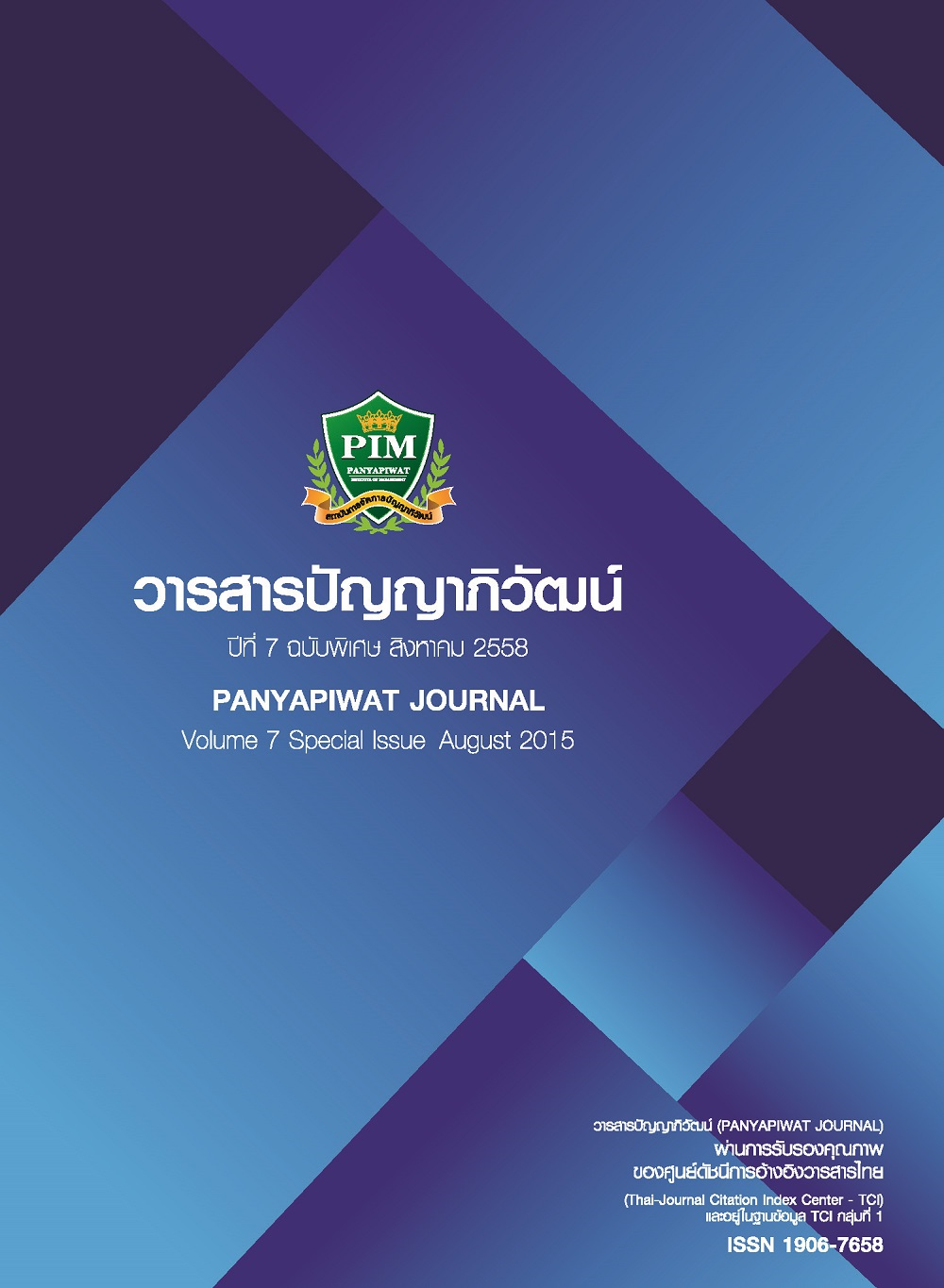แนวทางการพัฒนากลยุทธ์การตลาดของอาบน้ำแร่และภูมิปัญญาไทย เพื่อส่งเสริมอุตสาหกรรมการท่องเที่ยว: ดอยปู่หมื่น
Main Article Content
Abstract
การวิจัยมีวัตถุประสงค์เพื่อทราบถึงสถานการณ์ด้านการตลาดและแนวทางการพัฒนากลยุทธ์ด้านการตลาดของธุรกิจน้ำแร่เพื่อส่งเสริมอุตสาหกรรมการท่องเที่ยวดอยปู่หมื่น โดยใช้แบบสอบถามในการเก็บข้อมูลเชิงปริมาณ ซึ่งใช้การสัมภาษณ์แบบมีโครงสร้างในการรวบรวมข้อมูลจากประชากรและกลุ่มตัวอย่าง ได้แก่ ผู้ใช้บริการ จำนวน 240 ราย และผู้ประกอบการธุรกิจน้ำแร่ จำนวน 7 ราย การคัดเลือกกลุ่มตัวอย่างใช้วิธีแบบเจาะจง ผลการวิจัย พบว่า การให้ความสำคัญต่อการเลือกสถานบริการทั้งด้านตำแหน่งและรูปแบบ ในด้านของความสะดวกในการเข้าถึง ด้านความสะดวกสบาย ด้านความดึงดูดใจ ให้ความสำคัญในระดับมากในทุกด้าน สำหรับสถานการณ์ด้านการตลาดของธุรกิจน้ำแร่และภูมิปัญญาไทยควรมุ่งเน้น 1) การลงโฆษณาให้ตรงกลุ่มเป้าหมาย 2) การเจาะตลาดเป้าหมายที่ยังไม่ชัดเจน 3) สร้างสัมพันธมิตรแนวร่วมจากเพื่อนธุรกิจอื่นๆ 4) จัดให้มีกิจกรรมท่องเที่ยวและให้สิ่งตอบแทน 5) การติดต่อเชื่อมโยงกับธุรกิจต่างๆ ในภูมิภาคอื่นๆ และต่างประเทศ 6) การใช้เว็บไซต์ อี-คอมเมิร์ช และอินเทอร์เน็ต ในการประชาสัมพันธ์ธุรกิจน้ำแร่ โดยกลยุทธ์การตลาดเพื่อสร้างกลยุทธ์ทางการตลาดเพื่อให้ชุมชนดอยปู่หมื่นนำไปประยุกต์ใช้ประโยชน์ในการพัฒนาเพื่อส่งเสริมการท่องเที่ยว โดยมุ่งเน้นการเจาะตลาด หรือการวางช่องทางการจัดจำหน่าย เพื่อแสวงหากลุ่มเป้าหมาย และทำการประชาสัมพันธ์อย่างเหมาะสม โดยการสร้างกลยุทธ์ในการสร้างความสนใจให้กลุ่มเป้าหมายตัดสินใจมากใช้บริการ
This research aims to understand the marketing situation and guideline of marketing strategy development of mineral water business to promote tourism industry of Doi Pu Meun. The questionnaire was used to collect quantitative data and used structured interviews to gather information. Population and sampling are 240 consumers of mineral water and 7 mineral water entrepreneurs which were selected by using purposive or judgmental sampling method. The research results showed that when emphasis on the selection of the business for both location and pattern, in terms of facility to access the service, the conveniences, and attractiveness are all in high level. The marketing situation of mineral water business and Thai wisdom should focus on 1) Advertising should reach the right target 2) Market penetration should be clearer on the target 3) Create alliances from other kinds of businesses 4) Provide tourism activities or offer the rewards 5) Establish connectivity with other business in the same regions as well as abroad. 6) Use website, E-commerce and internet for mineral water business’ public relation. The marketing strategies are to let Doi Pu Meun community to apply to develop their tourism promotion by focusing on market penetration, distribution channel, seek the right target, and provide appropriately publicize by creating strategies to attract the target audience to decide to use the service
Article Details
I and co-author(s) certify that articles of this proposal had not yet been published and is not in the process of publication in journals or other published sources. I and co-author accept the rules of the manuscript consideration. Both agree that the editors have the right to consider and make recommendations to the appropriate source. With this rights offering articles that have been published to Panyapiwat Institute of Management. If there is a claim of copyright infringement on the part of the text or graphics that appear in the article. I and co-author(s) agree on sole responsibility.
References
การท่องเที่ยวแห่งประเทศไทย. (2554). แนวโน้มการท่องเที่ยวภาคเหนือ, กรุงเทพฯ: การท่องเที่ยวแห่งประเทศไทย
โครงการในพระราชดําริดอยปู่หมื่น. (2556). ดอยปู่หมื่น. สืบค้นเมื่อ 31 กรกฎาคม 2557, จาก htp://maesao.go.th/site/?p=97
ภูมินทร์ วรวรรณ. (2555). กลยุทธ์การตลาดของธุรกิจอาบน้ําแร่ อบไอน้ํา และภูมิปัญญาไทยเพื่อส่งเสริมอุตสาหกรรม การท่องเที่ยวของจังหวัดเชียงรายและเชียงใหม่, วิทยานิพนธ์ ศิลปศาสตรบัณฑิต, วิทยาลัยมหาวิทยาลัยเชียงใหม่.
รัฐนันท์ พงศ์วิริทธิ์ธร และภาคภูมิ ภัควิภาส. (2556). การพัฒนาการท่องเที่ยวเชิงวัฒนธรรมชนเผ่าเพื่อความยั่งยืน วารสารการวิจัยเพื่อพัฒนาชุมชน, 6(1), 42-60.
Bartol, K. M. & Martin, D. C. (1994). Management (2nd ed.). New York: McGraw-Hill, Inc.
Benge, S. (1999). The tropical spa and resort. Honk Kong: Periplus.
Hendel, D. (1977). Statistic. Minnesota: AERA Mini Presentation.
Kotler P., Bowen, J. & Markens, J. (2000). Marketing for Hospitality and Tourism. (2nd ed.). USA:Prentice Hall International, Inc.
McCarthy, E. J. & Perreault, W. D. Jr. (1996). Basic marketing: A global managerial approach. (12th ed.) Chicago: Irwin.
Translated Thai References
Doi Pu Meun Royal Development Projects. (2013). Doi Pu Meun. Retrieved July 31, 2014, from http://maesao.go.th/site/?p=97 [in Thai]
Pongwiritthon, R. & Pakvipas, P. (2013). Guidelines for Sustainable Tribe Cultural Tourism Development. Journal of Community Development Research, 6(1), 42-60. [in Thai]
Tourism Authority of Thailand. (2011). Trend of Northern of Thailand Tourism. Bangkok: Tourism Authority of Thailand. [in Thai]
Varavarn, P. (2012). Marketing Strategies for the Spa Sauna Business and Thai Wisdom to Promote the Tourism Industry in Chiang Rai and Chiang Mai Provinces. Thesis in Liberal Arts, Chiang Mai University. [in Thai]


